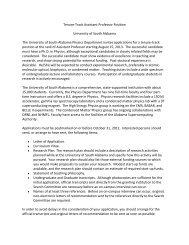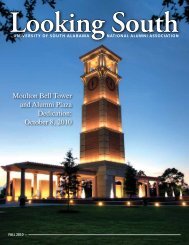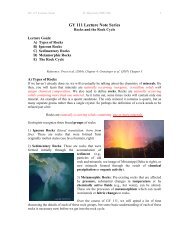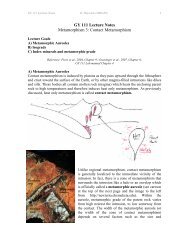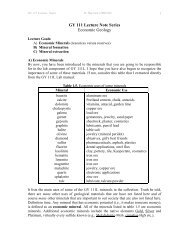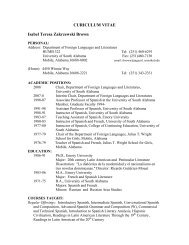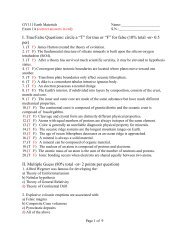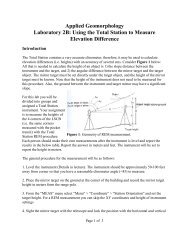Archaeological Survey of the Old Federal Road in Alabama
Archaeological Survey of the Old Federal Road in Alabama
Archaeological Survey of the Old Federal Road in Alabama
You also want an ePaper? Increase the reach of your titles
YUMPU automatically turns print PDFs into web optimized ePapers that Google loves.
appropriate for Moniac’s occupations <strong>of</strong> <strong>the</strong> <strong>in</strong>itial house (1809-1813) and <strong>the</strong> house built after <strong>the</strong> firstwas burned (ca. 1815-1818).Three historic-period nails were recovered, and none were clenched (hammered over, result<strong>in</strong>g <strong>in</strong>an “L” shape). Clenched nails are expected at structures made <strong>of</strong> sawn boards ra<strong>the</strong>r than logs. Thedearth <strong>of</strong> nails, <strong>the</strong>ir condition (not clenched, and one burned), and <strong>the</strong> presence <strong>of</strong> three burned ceramicsherds all suggests a log house that was burned, which co<strong>in</strong>cides with <strong>the</strong> meager historical evidenceavailable on Moniac’s house. His 1816 claim provides support for a small (most likely log) house, basedon his low estimate <strong>of</strong> its worth. Also recall Peggy Dow’s mention <strong>of</strong> only split wood available for ac<strong>of</strong>f<strong>in</strong>. Taken toge<strong>the</strong>r, <strong>the</strong> artifacts and historical documents support <strong>the</strong> <strong>in</strong>ference that Moniac’s housealong <strong>the</strong> <strong>Federal</strong> <strong>Road</strong> was made <strong>of</strong> hewn logs ra<strong>the</strong>r than sawn boards.The chronologically diagnostic artifacts recovered from our four excavation units <strong>in</strong>dicate anearly n<strong>in</strong>eteenth-century occupation <strong>in</strong> <strong>the</strong> area <strong>in</strong>vestigated. As for where exactly <strong>the</strong> structure stood, <strong>the</strong>number <strong>of</strong> diagnostic artifacts from <strong>the</strong> test units closest to <strong>the</strong> modern residence (Units 1 and 2) is greaterthan from <strong>the</strong> far<strong>the</strong>r units (3 and 4). Our overlay <strong>of</strong> <strong>the</strong> circa 1816-1817 Freeman survey plat on amodern topographic map places “Manack’s Store,” <strong>the</strong> second Moniac house, precisely where <strong>the</strong> modernresidence now stands. Our archaeological artifact distribution suggests <strong>the</strong> first house stood <strong>in</strong> <strong>the</strong> samelocation as <strong>the</strong> second.Household artifacts recovered by excavation provide some <strong>in</strong>formation on lifestyle and activitiesthat occurred at Moniac’s house on <strong>the</strong> <strong>Federal</strong> <strong>Road</strong>. The two Creek pottery sherds from <strong>the</strong> unitexcavations, <strong>in</strong> addition to <strong>the</strong> o<strong>the</strong>rs found dur<strong>in</strong>g shovel test<strong>in</strong>g, fit expectations that a Creek Indianhousehold would have some Creek ceramics even at <strong>the</strong> late date <strong>of</strong> 1809-1813. The s<strong>in</strong>gle identifiedvessel is a cook<strong>in</strong>g jar <strong>of</strong> <strong>the</strong> type used to make s<strong>of</strong>ki, a fermented th<strong>in</strong> corn soup consumed by <strong>the</strong> Creeksand unlikely to have been enjoyed by most travelers on <strong>the</strong> <strong>Federal</strong> <strong>Road</strong>. By 1810, wealthy Creekhouseholds would have rout<strong>in</strong>ely used English glazed pottery. The pearlware sherds with decorativestyles (edge decorated and hand pa<strong>in</strong>ted) and pla<strong>in</strong> creamware sherds found at Moniac’s house sitecorrespond to <strong>the</strong> types <strong>in</strong> wide use at <strong>the</strong> time <strong>of</strong> <strong>the</strong> Creek War. 22 The European ceramics are all serv<strong>in</strong>gvessels (plates and a saucer), perhaps types used to serve travelers. F<strong>in</strong>ally, <strong>the</strong> recovery <strong>of</strong> a Dutch ovenfragment fur<strong>the</strong>r ties <strong>the</strong> site with Moniac and his wealthy Creek Indian contemporaries. Moniac’s 1816claim <strong>in</strong>ventory lists two Dutch ovens and similar objects were recovered at Fort Mims (Figure 8-22). 23186




